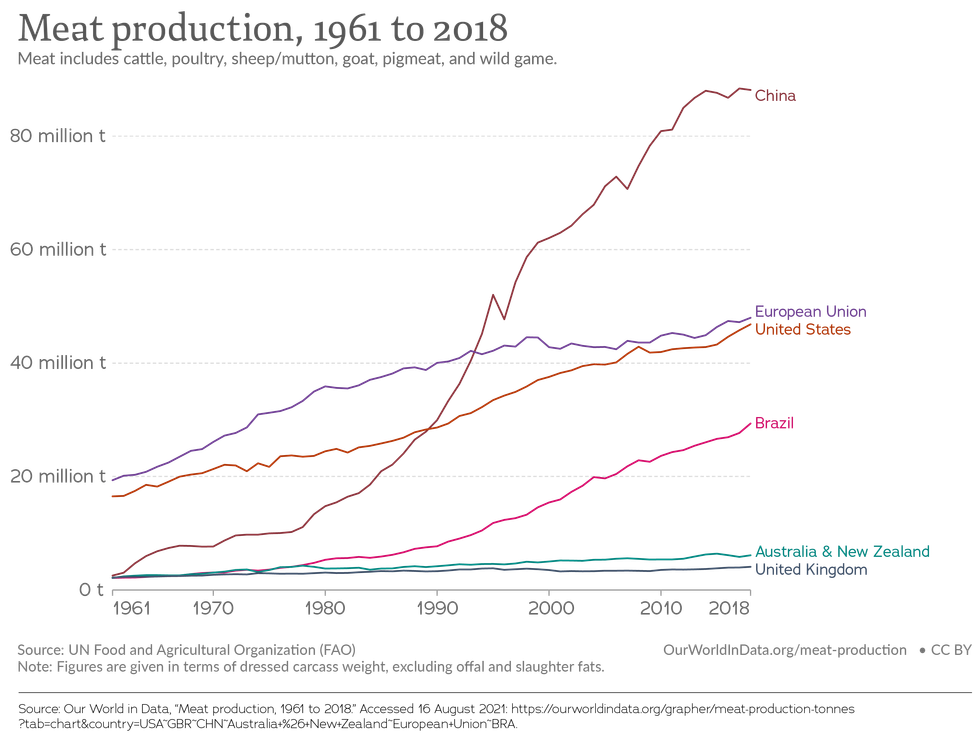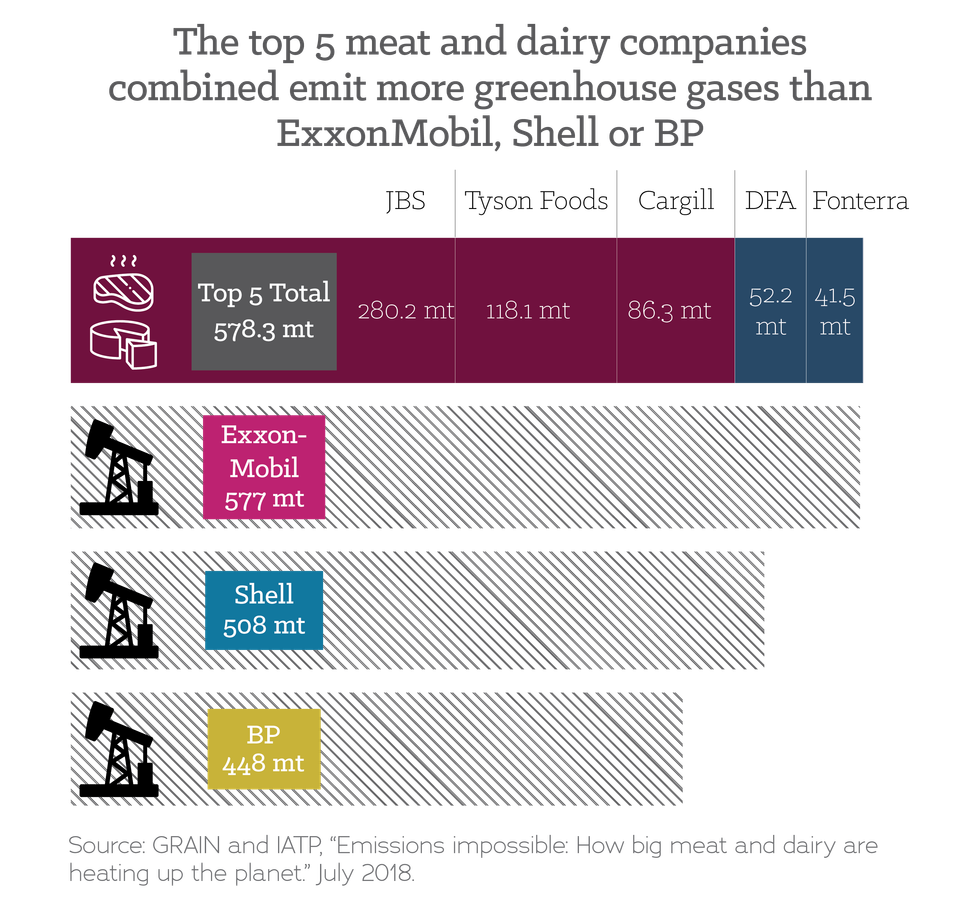Stringent methane reductions in the near term are vital to curbing global warming, state hundreds of scientists through the Intergovernmental Panel on Climate Change (IPCC)'s latest report on the physical understanding of the climate system and climate change. The report's crucial findings for agriculture and food production: the planet is certain to warm by 1.5degC sometime in the next 10-20 years accompanied by severe weather extremes, as in clearly discernible increases in the intensity and frequency of hot extremes, including heatwaves, heavy rainfall (therefore floods) and droughts. The last year of fires, floods and droughts can be expected to worsen and occur with greater frequency. Agriculture production in many regions of the world, particularly in Africa and Asia, but also the grain belt of North America and Central Europe, will be hard hit. With every additional .5degC rise in warming, "extremes" will be larger--we are already at 1degC.
Forty percent of the world's methane emissions come from agriculture, followed by fossil-fuels (35%) and waste (20%).
The IPCC report follows the Global Methane Assessment earlier this year. Methane has a global warming potential that is 84-87 times that of carbon dioxide over a 20-year period. While carbon remains in the atmosphere for at least 100 years, methane leaves within 12 years. Both reports make clear the quick reduction of the greenhouse gas (GHG) is critical to avoid further climate breakdown and overshooting 1.5degC. The IPCC report found that methane levels were the highest they have been in 800,000 years. But if we can slash the emissions of this short-lived pollutant now, we can buy time as we simultaneously reduce carbon emissions.
Forty percent of the world's methane emissions come from agriculture, followed by fossil-fuels (35%) and waste (20%). Livestock contribute 32% of the methane footprint with industrial livestock production a major driver, particularly in the last 30-40 years. Yet, governments beholden to powerful global meat and dairy companies around the world have done little to curb these emissions. Currently, not one single government around the world requires that meat companies report their emissions or standardize their emissions reduction targets so that they can be compared across the sector. Nor do governments require these companies to have emission reduction targets.

Since 2013, IATP has been documenting the ascendence of the global industrial meat complex in the U.S. and EU, China and Brazil. In 2018, IATP, together with GRAIN, calculated the emissions of 35 of the world's largest meat and dairy producing companies, using the FAO's Global Livestock Environmental Assessment Model (GLEAM). The findings were staggering: in one year, the top five meat and dairy companies combined (JBS, Tyson, Cargill, Dairy Farmers of America and Fonterra) had more emissions than Exxon or Shell or BP. Twenty companies had more greenhouse gas emissions than Germany, the United Kingdom or France's total emissions. Out of these 20, six are headquartered in the EU (Lactalis, Arla, Nestle, Friesland Campina, Danish Crown and Vion), six in the U.S. (Tyson, Cargill, Dairy Farmers of America, Dean Foods California Dairies--U.S.-based National Beef has since been acquired by Brazil's Marfrig), four are headquartered in Brazil (JBS, Marfrig, Minerva, BRF), two in China (WH Group/Smithfield, Yili), Fonterra in New Zealand and Saputo in Canada. Only New Zealand has enacted a climate law that commits to methane reductions--only 10% of methane from agriculture by 2030, though agriculture accounts for half of the country's emissions.
Last year, in our Milking the Planet report, we updated our emissions estimates of the dairy companies covered in our first report. We found that the total combined GHG emissions of the world's 13 largest dairy corporations had risen by 11% over a two-year span (2015-2017), with some corporations increasing their emissions by 30%. Their combined emissions were more than the United Kingdom's, host of the next United Nations climate conference at the end of this year. This increase in emissions by 32.3 million tonnes (MtCO2eq) of GHGs equates to the pollution stemming from 6.9 million passenger cars driven in one year. Industry-led techno fixes to reduce emissions per kilo of milk will not be enough. The Dairy Platform's joint study with the FAO reports that the industry reduced emission intensity by 11% between 2005-2015; however, its overall emissions increased by 18% in that same period. This is because these companies dramatically increased their worldwide operations and the number of animals in their supply chains, even as they reduced emissions per litre of milk processed.

We need a systemic shift in how meat production and dairying is done to restore our climate and rural communities. This necessitates four major steps in the next year:
- All major meat and dairy producing countries (U.S., EU, Canada, China, Brazil, New Zealand and Australia) must commit to stringent methane reduction targets in their Nationally Determined Contributions (NDCs) before COP 26 in Glasgow.
- They must enact legislation that standardizes emissions reductions of the sector, requiring companies to report on their emissions and set targets that fulfil each country's emissions reductions commitments on methane, CO2 and the most potent GHG, nitrous oxide, tied to fertilizer use.
- These targets must be complementary and in tandem with other regulations that set targets for ecosystem restoration and strengthen existing or enact new regulations on nitrate runoff on land and water bodies.
- They must redirect public funds to help support a transition out of industrial livestock production towards regenerative agroecological systems that ensure farmers are paid their cost of production plus a reasonable profit.
Some scientists are floating the idea of launching a Global Methane Agreement at COP 26. The idea is certainly compelling. We need to act with a sense of global urgency to save agriculture and food systems. However, such an initiative would only be worthwhile if we set a binding goal to complete it within one year. It took governments 14 years between discovering the hole in our ozone and finalizing the Montreal Protocol to solve the crisis. In contrast, we have known about the urgency of climate change for at least 40 years. The latest IPCC report confirms rather than conjectures that we are faced with a 1.5degC world in the next decade.
Academics from New York University make a compelling case that governments must take ownership of the emissions generated by meat and dairy companies headquartered in their countries and enshrine these emissions reductions in their NDCs. We agree. Since the signing of the first climate treaty, governments have lost three decades in the fight against climate change because they failed to regulate and phase out the fossil fuel industry. We have run out of decades to make the same mistakes. The science is clear: Regulating global meat and dairy companies, making the cost of business as usual untenable and supporting a transition toward agroecological systems of food production are critical if we hope to stem climate chaos.



